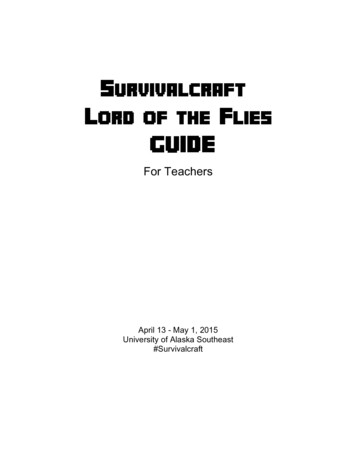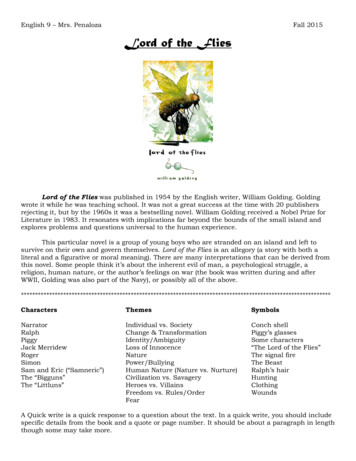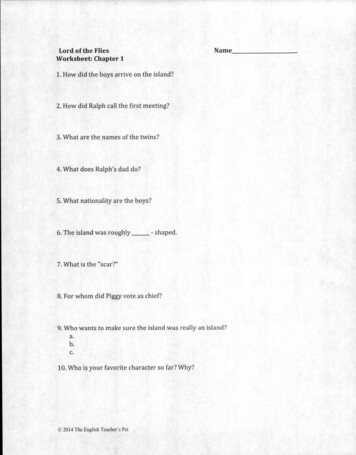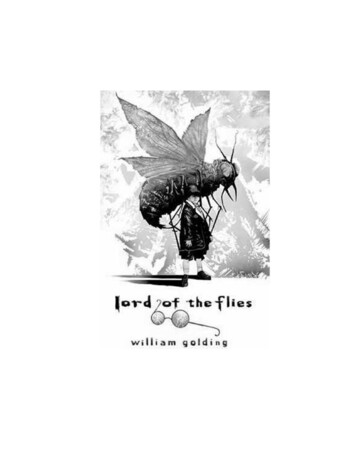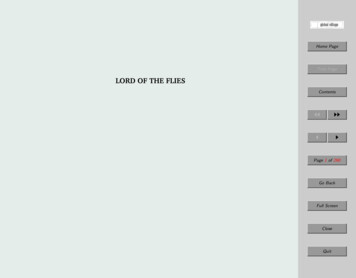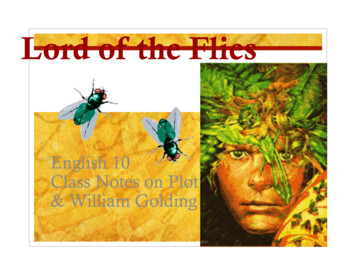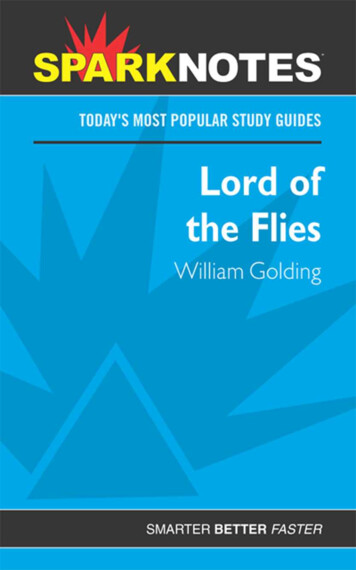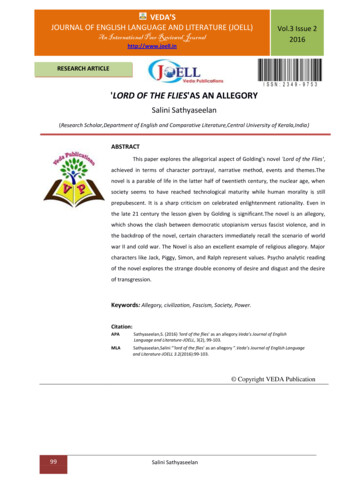
Transcription
VEDA’SJOURNAL OF ENGLISH LANGUAGE AND LITERATURE (JOELL)An International Peer Reviewed Journalhttp://www.joell.inVol.3 Issue 22016RESEARCH ARTICLE'LORD OF THE FLIES'AS AN ALLEGORYSalini Sathyaseelan(Research Scholar,Department of English and Comparative Literature,Central University of Kerala,India)ABSTRACTThis paper explores the allegorical aspect of Golding's novel 'Lord of the Flies',achieved in terms of character portrayal, narrative method, events and themes.Thenovel is a parable of life in the latter half of twentieth century, the nuclear age, whensociety seems to have reached technological maturity while human morality is stillprepubescent. It is a sharp criticism on celebrated enlightenment rationality. Even inthe late 21 century the lesson given by Golding is significant.The novel is an allegory,which shows the clash between democratic utopianism versus fascist violence, and inthe backdrop of the novel, certain characters immediately recall the scenario of worldwar II and cold war. The Novel is also an excellent example of religious allegory. Majorcharacters like Jack, Piggy, Simon, and Ralph represent values. Psycho analytic readingof the novel explores the strange double economy of desire and disgust and the desireof transgression.Keywords: Allegory, civilization, Fascism, Society, Power.Citation:APASathyaseelan,S. (2016) 'lord of the flies' as an allegory.Veda’s Journal of EnglishLanguage and Literature-JOELL, 3(2), 99-103.MLASathyaseelan,Salini “'lord of the flies' as an allegory ”.Veda’s Journal of English Languageand Literature-JOELL 3.2(2016):99-103. Copyright VEDA Publication99Salini Sathyaseelan
VEDA’SJOURNAL OF ENGLISH LANGUAGE AND LITERATURE (JOELL)An International Peer Reviewed Journalhttp://www.joell.inINTRODUCTIONLord of the Flies was originally titled ‘TheStrangeness Within “and was published 29 yearsbefore Golding won Nobel prize for literature. It is aParody of a famous adventure story of boys inBallantyne’s Coral Island .In Ballantyne’s Coral island,three castaway boys cherish their sweet memoriesabout the happy days they had spend on island. ButGolding in his novel gives us a very bleak unpleasantpicture of life. Golding already points out that hisnovel is not about adventures or happiness.He says,“Ballantyne’s island was a nineteenth centuryisland inhabited by English boys; mine was to be atwentieth century island inhabited by English boys”Lord of the Flies is a perfect example ofallegory. Allegorical aspect is achieved in terms ofcharacter portrayal, narrative method, events andthemes. Golding ridicules the enlightenment and itsrationality. Golding was a contemporary of Adornoand Horkheimer for whom the enlightenmentrationalism was nothing but a mass deception.'Reason' is nothing more than a 'construct' setagainst 'unreason'. He feels that 'civilization'emerged after the enlightenment is nothing morethan a mask which covers evil inherent in humannature. Golding challenges the common belief thatafter the enlightenment savages of middle agesemerged as refined human being who think and actwith their reasoning capacity. Golding points out thatmiddle age and age of reason lies within oneself.Lord of the Flies flashes light on the deeperrealities of human mind. He illustrates how humansbehave in strange ways while they are in small orlarge group situations. When people forget abouttheir mortal existence they may wage wars till theirdeath takes them away from this world. War is thedestiny of every society which forgets about itsexistence. The Novel is a parable of life in the latterhalf of twentieth century, the nuclear age, whensociety seems to have reached technological maturitywhile human morality is still prepubescent.It is said that anti puritan dream is realizedin Lord of the Flies. When puritans lost their grip onpower, people celebrated their freedom. Later on,this unchecked freedom led society into a state of100Vol.3 Issue 22016perversion. This was visible in literature especiallyliterature of restoration period.DEFINITION OF ALLEGORYBefore analysing the novel as an allegory,let us have a look on definition of allegory. Accordingto M H Abrams“Allegory is a narrative, whether in prose orverse, in which agents and actions, andsometimes the setting as well, are contrivedby the author to make coherent sense onliteral or primary level of signification and atthe same time to communicate a second,correlated order of signification”. (2009, p 15)There are historical and political allegories inwhich the character and actions stand for historicalpersonages and events. In the second type ofallegories that is 'allegory of ideas', central device isthe personification of abstract entities such asvirtues, vices, state of mind, modes of life and typesof character and places. Lord of the Flies is a beautifulfusion of these two types of allegories.POLITICAL ALLEGORYAccording to Diken and Lausten Lord of theFlies is an allegory of a bio political or post politicalsociety that elevates “security” to the most sacredprinciple of organization. This is evident from thestory line on the backdrop of socio political conditionof era in which it was written.The two 'clans' the boys establish on theisland, those led by Ralph and Jack, explicate the twosides of the society .The one led by Ralph stands forinstitutionalised part of society where people abideby rules and harmony is maintained. The other partshows dark side of the same society in whichfantasies of transgression and perversion takes place.We can read the story in the background of rising offascist powers during the time of World war II andthe clash is between democratic utopianism versusfascist violence, society versus mob. Ralph the fairleader appeals to reason and order, while Jack areplica or minimized image of fascist leaders unitesboys by creating a monster, a common enemy whichexists only in the realm of imagination.Choir boys symbolizes blind followers.“Choir stand still wearily obedient the choirhuddled into line and stood there swaying in theSalini Sathyaseelan
VEDA’SJOURNAL OF ENGLISH LANGUAGE AND LITERATURE (JOELL)An International Peer Reviewed Journalhttp://www.joell.insun”. This is a small description of choir boys.(Golding, 1954, p 26)This may explicitly stand for Nazi followers ofHitler. Golding explains how in the crowd, consciouspersonalities disappear, and members take one andsame direction. Individuals will obey the leader andlike in a trance he can act in contradiction with hisindividual character.The conch is significant in the context.Conch represents law and order as well as freedomof expression. Whoever possesses the conch is theonly person admitted to talk at the time. Piggy shoutsat older boys ' Let him have the conch '. In order togive younger boys a chance to speak. Piggy embracesideology of democracy and for him ' unsettlingly ‘ itmatters just as much as the older boys do. Littlunsalso participate in the election process. When conchis broken into pieces at castle rock, law and order tooends. Disorder consumes the boys after it. Conchrepresents order authority, dialogue and democracy.There is also an allegoric relation to the coldwar. The beast represents communism. During thecold war, the main fear of people was the spread ofcommunism .Leaders used this fear to rise to powerand do what they wanted.Each and every character in the novelrepresents something more than his self. Theysymbolizes certain ideas. One of the reasons for thefame and popularity of this novel is it is not only apolitical allegory but also an allegory of ideas. Eachcharacter stands for historical personages and at thesame time they represent a part of human nature. Itachieves political, religious and psychologicalsignificance at same time and becomes allegory ofhumanity as a whole. Critic Reily in his essay “Lord ofthe Flies: Fathers and sons” notes that the book “hasbeen read as a moral fable of personal disintegration,as a social fable of social regression, as a religiousfable of the fall of man”.(Reilly, 1992)Ralph the twelve year old intelligent boytakes the responsibility of all and becomes leader.E M Foster describes Ralph in an introduction to oneof the novels edition as “He is sunny, decent sensibleand considerate”. He is committed to the welfare ofhis fellow companions. Ralph is the representative ofcivilized world. He uses reason and intelligence tofind out the monster. He organizes everything,101Vol.3 Issue 22016maintains peace and order and ultimately chased bysavages. He stands for democratic idea of welfareand humanity. One can join either in Ralph's group orin Jack's .Ralph also stand for a democratic leaderwho always gives value to others opinion. Ralphrepresents reasoning capacity and humanity whichdifferentiate man from animal.Jack the enemy of Ralph carries justopposite character trait of Ralph. Jack is a real savagewhose hunger for power makes him blind. WhenRalph is elected as leader, fury bubbles in him and healmost becomes a silent simmering volcano .Theknife and his hunting excursion recalls the image ofstone age man. His painted face not only covers hisfeelings but also helps to push out even the last dropof humanity in him. Jack metaphorically stands fordark side of all personalities.Jack is nothing other than a minimizedfigure of Hitler. He is a usurper and rules like anautocratic chief. Like Ralph his leadership qualitydoes not come from his good superior personalitybut from his capacity to frighten his followers intoimplicit obedience. Jack develops his totalitarianstate and military regime. He creates a commonenemy in order to unite hunters and his politics areaestheticised through putting some painting on faceand garlanding. He is a mini Hitler who has declaredJews as the common enemy and united Germanyunder the banner of fascism. Jack soon follows themethod of exterminating his friends and follows aholocaust in which Piggy and Simon are brutallykilled. For Jack “Fair is foul and foul is fair”.Piggy's comment on Ralph makes it clear“Which is better – to be a pack of painted indianslike you are or to be sensible like Ralph is”.(Golding, 1954, p 259)Piggy stand for intelligence and Ralph knows hisvalue .Piggy believes in an organized society andrespect authority. Piggy thinks in a worldly wisescientific manner regarding the rumours of beast. Heis aware of the changes in his fellow companions andasks the question.“What are we? Humans? or animals? or savages?(Golding, 1954, p 129)Piggy has been ridiculed, hurt and finallykilled only because he gave advises to the savages.Great philosophers and those who think 'differentlySalini Sathyaseelan
VEDA’SJOURNAL OF ENGLISH LANGUAGE AND LITERATURE (JOELL)An International Peer Reviewed Journalhttp://www.joell.in'from others always face same fate either it is in theform of death or exile. Piggy's spectacles stand forclose observation of human mind and its nature.Piggy called a spade a spade and that was hismistake. Piggy is doomed in a society where irrationalfears and physical strength are more respected thanscience, law and dialogue.RELIGIOUS ALLEGORYNovel takes the form of Religious allegoryespecially through the character Simon. None of thecharacters other than Simon functions solely as a partof allegory. The name of the novel can be traced backto the Jewish hierarchy of demons where Beelzebubis referred to as “Lord of the Flies”. He is the chiefrepresentative of false Gods. Anderson defines thecentral theme of Lord of the Flies as a statement ofwhat it is like to experience the fall from innocenceinto sin and to experience damnation. The island,beautiful and abundant of tasty food recalls theGarden of Eden in which Adam and Eve once livedhappily. When Jack the metaphorical serpent temptsother boys showing meat and turns them againstRalph, the heaven turns to a hell. However redeemercomes in the form of Simon. Simon symbolises thefaith. He possesses spiritual qualities like kindness,virtue ,generosity and ultimately courage to searchthe truth. He is the spiritual leader and a prophet.When all boys are chilled with the fear of beast ,Simon goes off alone into the forest and discoversthat so called beast is nothing but a rotten dead bodyof an airman entangled in his parachute. Simon triesto unveil the secrecy. .But in that attempts he is killedby his companions. They mistake him for a beast andkills him in the midst of frantic dance. Christ, theredeemer of mankind too was crucified for preachingthe gospel truth. Thus evil walks out with crown bykilling reason, intelligence and virtue.The story is not the tragedy of some boysbut tragedy of all humanity, in which grown up 'children ' flies to cut the throat of his fellowcompanions. Golding ridicules the civilization ofwhich mankind is proud. It is nothing but a superficialouter cover which covers the real nature in the timeof crisis and cause real nature of human manifestitself.The war against evil is not matter ofopposing others, but of confronting ourselves, our102Vol.3 Issue 22016own desires. So Lord of the Flies talks about evilinherent in us. In the famous preface for “AntiOedipus” Foucault claimed that “the major enemy,the strategic adversary is fascism . And not onlyhistorical fascism, the fascism of Hitler andMussolini. but also the fascism in us that causes usto love power, the desire the very thing thatdominates and exploit us”(“Anti Oedipus” 11)Simon hears this from the Lord of the Flies“Fancy thinking the beast was somethingyou could hunt and kill . You knew, didn'tyou? I am part of you? close close close! I amthe reason why it's no go? Why things arewhat they are”. (Golding, 1954, p 206)So the boys who escaped from the devilishworld now caught on their own. Criticism of the Lordof the Flies began with Golding himself. Hesummarizes the theme as follows“It is an attempt to trace the defects of thesociety back to the defects of the humannature. . .The moral is that the shape of asociety must depend on the ethical nature ofthe individual and not on any political adury, 2013, p 63)Author makes it clear that civilization shouldcome out from inside, from the depth of the soul, ithas nothing to do with sophisticated life style. It is allabout one's morality, ethics and values whichultimately lead to a harmonious social life. WhatGolding insists is not rule of law but one’s ability torule himself.PSYCHO ANALYTIC READINGA psychoanalytic reading of the text in thiscontext will be more useful. The Story is presentedultimately as the conflict between civilization andbarbarism, in depth it is about clash between id(Jack)pleasure principle, which stands against ego (Ralph)reality principle and super ego(Simon) moralityprinciples. Boys are under the influence of twosimultaneous emotions, they are both fascinated andterrified by nature outside and inside.“Taboo and transgression are reflected inthese two contradictory urges . . . The taboowould forbid the transgression but thefascination compels it”. According to theauthors “this strange double economy ofSalini Sathyaseelan
VEDA’SJOURNAL OF ENGLISH LANGUAGE AND LITERATURE (JOELL)An International Peer Reviewed Journalhttp://www.joell.indesire and disgust, of object and abject or oftransgression and confirmation is theunderlying matrix of the novel. Bülent Dikenand Carsten Bagge Laustsen (Diken & Lausten,2006, p 436)Jack represents the impulsiveness andcruelty, Piggy, intelligence and Simon artistic andreligious side. Ralf stands for an overall being. Thethree ring characters share qualities that connectthem. Piggy and Jack has desire to lead but Simondoes not have any such desire. Piggy and Simonrepresent morals, Jack has none. Jack and Simonshare the passion. Jack's passion rests in huntingwhile Simon's rest in nature/life while Piggy is plain.CONCLUSIONLord of the Flies thus becomes an excellentexample for a political and religious allegory as wellas allegory of ideas. James Stern pointed out in 1955review for the New York Times Book Review that“Lord of the Flies is an allegory on human societytoday; the novel's primary implication being thatwhat we have come to call civilization is at best nomore than skin deep”This novel has been praised on literarygrounds much less often than a sociologicalpsychological or religious tract. The bleak picturepresented in the novel rises thought provokingquestions in readers mind, especially aboutcivilization, enlightenment rationality and the humannature. The Novel was criticized because it isderivative, filled with gimmickry, devoid ofcharacterization and lacking in logicGolding replies to this criticism by saying that“I am by nature an optimist; but a defectivelogic- or a logic which I sometimes hopedesperately is defective-makes a pessimist ofme." (Golding, On the Crest of the Wave)Woodroofe comments “Lord of the Flies is by nomeans entirely bleak, and encourages us to identifyhumanity with its humanity and not with itsinhumanity".(Murray, 1991, p 791)[3]. Diken, Bulent, & Laustsen Carsten Bagge.(2006). FromWar to War :Lord of the Flies as the sociology spite.JSTOR. 31(4),pp 431-452.[4]. Golding, William. Lord of the Flies. New Delhi:UBSPublishers.[5]. Murray , Brian.1991.William Golding Revisited :Acollection of original essays , and Word andStory in C SLewis and Time and Anthony Powell : A Critical Study.PROJECT MUSE, 37(4),pp 790-792[6]. Patrick Reilly.1992.Lord of the Flies:Fathers andSons.Retrieved from[7]. https://books.google.co.in/books?id lJt CgAAQBAJ&pg PT29&lpg PT29&dq Lord of the Flies: Fathers and sons%E2%80%9D notes that the boo&source bl&ots wSgSHNvRqH&sig ZWijZqILIMw7UdINurIjfjWyqY&hl en&sa X&ved 0ahUKEwjb562U2MTMAhWBBo4KHTljDEQ6AEIGzAA#v onepage&q E2%80%9D%20notes%20that%20the%20boo&f false [8]. Singh , Minnie.1997. The Government of Boys:Golding's Lord of the Flies and Ballantynes CoralIsland.PROJECT MUSE,25, pp 205-213.REFERENCES[1]. Abrams,M H .2009. A handbook of Literary Terms. NewDelhi: Sengage Learning India Private Limited .[2]. Bhadury P.Beyond the Binary: A Study of the Fiction ofWilliam Golding, Doctoral diss.,Kumaun University,Nainital.2013.103Vol.3 Issue 22016Salini Sathyaseelan
Lord of the Flies is a beautiful fusion of these two types of allegories. POLITICAL ALLEGORY According to Diken and Lausten Lord of the Flies is an allegory of a bio political or post political society th


